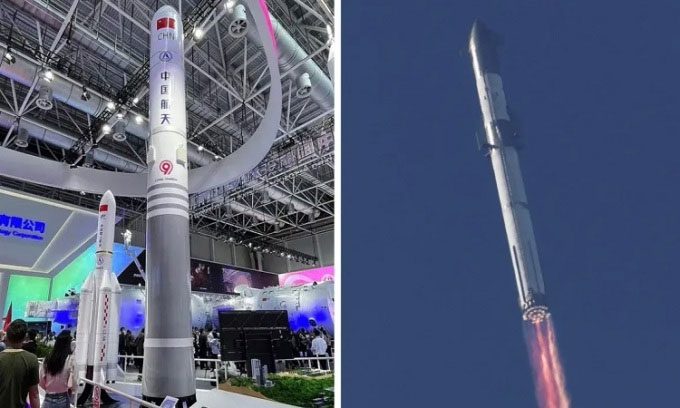Compared to the Long March 9 rocket, SpaceX’s Starship launch system generates greater thrust thanks to its next-generation Raptor engines.
Recently, China announced a change in its plans for the new Long March 9 rocket. This super heavy-lift rocket, designed for deep space missions, will no longer be a single-use vehicle. Instead, like SpaceX’s Starship launch system, it will be a fully reusable rocket, which will help reduce the costs of subsequent missions.

Models of the Long March 9 rocket (left) and Starship launch system (right) during the first launch test. (Photo: Interesting Engineering).
The announcement about the Long March 9 rocket was somewhat overshadowed by SpaceX’s successful but explosive first launch of the Starship. The announcement was made at the end of April during China’s National Space Day in Hefei, Anhui Province, just a few days after Starship lifted off in its first flight test on April 20.
The Long March 9 is being developed by the China Academy of Launch Vehicle Technology (CALT). This will be a three-stage rocket powered by several methane-burning engines in a staged full-cycle configuration attached to the first stage. If everything goes according to plan, CALT also aims to create a two-stage version of the Long March 9 for missions to Low Earth Orbit (LEO). This marks a significant shift for China from its initial plan to build a single-use Long March 9 rocket equipped with a 500-ton thrust engine powered by kerosene and liquid oxygen. This rocket is expected to fly around 2028 – 2030, while the Long March 9 version similar to Starship will require a few more years for development.
Clearly, both China and the world are closely monitoring the development of the fully reusable Starship launch system. In fact, CALT recently released a frame-by-frame video analysis of the launch. Earlier this year, the European Space Agency released a report emphasizing that Europe needs to invest more in the space industry if it wants to avoid falling behind.
The most significant numbers when comparing the Long March 9 and Starship are the development timelines for each rocket system. The Starship launch may face several delays, but SpaceX is still leading and making breakthroughs, offering unprecedented capabilities for the space industry.
Although SpaceX may have to wait some time before receiving permission from the Federal Aviation Administration (FAA) for a second launch test, the company employs a “failure is the mother of success” approach to quickly improve designs. Starship will send crew members into space in the near future. Although launch dates are frequently changing, Starship is tasked with the dearMoon mission expected to take place later this year, as well as landing on the Moon in NASA’s Artemis 3 mission in 2025 or 2026.
In comparison, China is aiming for 2023 for the first flight of the Long March 9. However, the country will produce several versions, and the first rocket model will only have a reusable first stage, capable of carrying 35 tons to a lunar transfer orbit. According to SpaceNews, it will not be until 2040 that a fully reusable version of the Long March 9 will take flight, which could carry 80 tons to LEO. In terms of payload, Starship is expected to carry 100 – 150 tons to LEO when fully operational in the near future.
The initial version of the Long March 9 will stand 114 meters tall and produce 6,100 tons of thrust. In contrast, Starship is 120 meters tall and generates 7,590 tons of thrust at liftoff. The greater power of the Starship launch system is partly due to the next-generation Raptor engines. The first stage, named Super Heavy, uses 33 Raptor engines to provide immense thrust.
The decision to redesign the Long March 9 rocket could delay plans for the International Lunar Research Station (ILRS) to compete with NASA’s Gateway project. China is also developing the Long March 10 rocket, which could fly for the first time in 2017. If everything goes according to plan with Long March 10, China hopes to land astronauts on the Moon’s surface before 2030.





















































